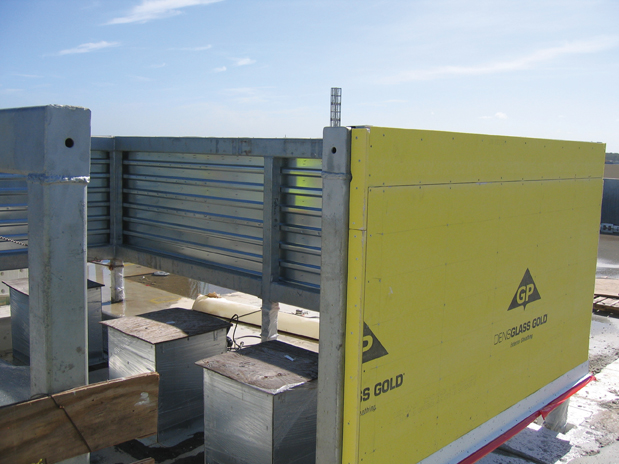Collman & Karsky does much of its work in coastal Florida, designing mission-critical facilities that are hurricane-hardened, meaning they’re resistant to high winds, flooding, and the impact of large airborne missile debris—flying chunks of wood and metal, even whole pieces of rooftop HVAC equipment. For one recent project, a renovation of the Sarasota Emergency Data Center, Collman & Karsky used Wellbilt’s Sure-Board Wall Panel, a modular, panelized wall system, to create a bunker able to withstand a Category 5 hurricane.
Karsky says the product was very clean and easy to install and required no cutting of floor slabs. “We were on an extremely tight time frame, and because it was modular, the walls could be set up quickly, allowing the other trades to come in and start working.” The modular system also cost “a little bit less” compared to concrete block or poured-in-place concrete, he says.
Hasan S. Arouri, PE, principal and senior structural project engineer for TLC Engineering for Architecture in Orlando, also attests to the benefits of the Wellbilt system: “The panels are tested and certified as hurricane-resistant, impact-resistant, and blast-resistant products, adequate and cost-effective to provide additional protection and strength for buildings located in high-velocity hurricane zones.”
TLC used them to harden the walls of the Florida Supreme Court Building in Tallahassee. Arouri says the technology provided a lightweight solution that strengthened the existing walls, enhancing their capacity to resist lateral hurricane wind pressures and providing blast-wall protection without the need for a lot of additional footings. The panels also allowed the building’s historic façade to be preserved.
Related Stories
| Nov 2, 2010
Energy Analysis No Longer a Luxury
Back in the halcyon days of 2006, energy analysis of building design and performance was a luxury. Sure, many forward-thinking AEC firms ran their designs through services such as Autodesk’s Green Building Studio and IES’s Virtual Environment, and some facility managers used Honeywell’s Energy Manager and other monitoring software. Today, however, knowing exactly how much energy your building will produce and use is survival of the fittest as energy costs and green design requirements demand precision.
| Nov 2, 2010
Yudelson: ‘If It Doesn’t Perform, It Can’t Be Green’
Jerry Yudelson, prolific author and veteran green building expert, challenges Building Teams to think big when it comes to controlling energy use and reducing carbon emissions in buildings.
| Nov 2, 2010
Historic changes to commercial building energy codes drive energy efficiency, emissions reductions
Revisions to the commercial section of the 2012 International Energy Conservation Code (IECC) represent the largest single-step efficiency increase in the history of the national, model energy. The changes mean that new and renovated buildings constructed in jurisdictions that follow the 2012 IECC will use 30% less energy than those built to current standards.
| Nov 1, 2010
Sustainable, mixed-income housing to revitalize community
The $41 million Arlington Grove mixed-use development in St. Louis is viewed as a major step in revitalizing the community. Developed by McCormack Baron Salazar with KAI Design & Build (architect, MEP, GC), the project will add 112 new and renovated mixed-income rental units (market rate, low-income, and public housing) totaling 162,000 sf, plus 5,000 sf of commercial/retail space.
| Nov 1, 2010
John Pearce: First thing I tell designers: Do your homework!
John Pearce, FAIA, University Architect at Duke University, Durham, N.C., tells BD+C’s Robert Cassidy about the school’s construction plans and sustainability efforts, how to land work at Duke, and why he’s proceeding with caution when it comes to BIM.
| Nov 1, 2010
Vancouver’s former Olympic Village shoots for Gold
The first tenants of the Millennium Water development in Vancouver, B.C., were Olympic athletes competing in the 2010 Winter Games. Now the former Olympic Village, located on a 17-acre brownfield site, is being transformed into a residential neighborhood targeting LEED ND Gold. The buildings are expected to consume 30-70% less energy than comparable structures.
| Oct 27, 2010
Grid-neutral education complex to serve students, community
MVE Institutional designed the Downtown Educational Complex in Oakland, Calif., to serve as an educational facility, community center, and grid-neutral green building. The 123,000-sf complex, now under construction on a 5.5-acre site in the city’s Lake Merritt neighborhood, will be built in two phases, the first expected to be completed in spring 2012 and the second in fall 2014.
| Oct 21, 2010
GSA confirms new LEED Gold requirement
The General Services Administration has increased its sustainability requirements and now mandates LEED Gold for its projects.
| Oct 18, 2010
World’s first zero-carbon city on track in Abu Dhabi
Masdar City, the world’s only zero-carbon city, is on track to be built in Abu Dhabi, with completion expected as early as 2020. Foster + Partners developed the $22 billion city’s master plan, with Adrian Smith + Gordon Gill Architecture, Aedas, and Lava Architects designing buildings for the project’s first phase, which is on track to be ready for occupancy by 2015.














